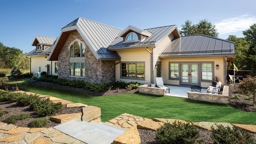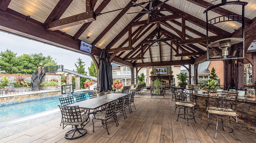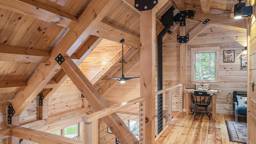
Drawing up your ideal timber frame home can be a lot of fun. You can add several spacious rooms here, top-of-the-line appliances there. How about a hot tub? Perhaps a backyard putting green? Everything and anything can be done in the planning stage. But unless you can find a way to turn that paper to cash, that's exactly where your fantasy home will remain.
There's nothing wrong with dreaming. But knowing what the project could cost will help you modify your plans to stay within your budget.
Your building budget will serve as the financial plan for your entire design and construction process. The primary purpose of a budget is to understand and control costs so that you don't run out of money before your house is complete. "This sounds painfully obvious, but you'd be surprised how often it happens that people run short of cash," says Chris Wagg of Normerica in Ontario, Canada. "We try to make our clients aware of their total construction cost, not just the timber frame portion. Usually about 40 percent of the total project cost is the timber frame shell package. You still have foundation costs, labor, land and the remainder of materials needed to finish off the house."
First Things First: Price Everything
You've probably clipped a file of pictures from magazines like this one, documenting what you'd like to incorporate into your new home. That's a good start. But now you have some real homework to do. To find out what these picture-perfect rooms might cost, first contact several local builders who build timber frame homes similar in size, quality and features to the home you want to build. A builder should at least give you a rough estimate. Most builders will break it down by the foot. "Per square foot is a good rule of thumb as long as you're cautious as to what is included in that price," explains Chris.
There can be so many variables it becomes impossible to analyze what you're actually getting. You need to gather more information. Are you comparing apples to apples? Are the types of allowances the same? Are we talking the same level of finish? What are the labor costs, building permit fees and code requirements that could drive up the final cost?
The only way to be sure is to identify and price every item that will be used to build your home. And in order to do that, you will need to have detailed blueprints. The problem then is whether to go to the time and expense of making the prints, only to find out you aren't even close to affording your dream home once the bids come back.
So a better approach might be to work backwards: First, determine how much you can afford to spend, then design a house that will fit into that budget.
What's Your Bottom Line?
Without a realistic bottom line, it will be very difficult to compare timber frame companies, contractors and specific designs. "Many times people come in with their dream, only to realize it's beyond their reach," says Chris. "So one of the first questions we ask is whether they have a budget in mind. If they don't, we'll help them develop one."
To eliminate the guesswork, he recommends prequalifying for a home loan. Prequalification can be of service in many ways. First it will let you know whether you'll be approved when you are ready to apply. And once you know exactly what you can borrow, you can easily add or rule out details that you're interested in before you get too far into the project.
The maximum loan amount will be determined by the value of the property you'll purchase and your personal financial condition. Lenders will usually lend the borrower up to a certain percentage of the appraised value of the property, such as 80 or 90 percent, and will expect a down payment to make up the difference.
"When looking at your projected mortgage payment and existing debt, it's common to go with debt-to-income ratios such as 28 and 36 percent to determine whether you will qualify," explains Annette Edens, a home loan officer with the American National Bank and Trust Company in Chicago. "These are commonly used ratios." The "28" refers to the percentage of your gross income that may be spent on housing expenses, including principal and interest on the mortgage, real estate taxes and insurance. The "36" refers to the income that may be spent for payments on all your debts. "When you talk to a lender, find out what ratios will be used to evaluate your application," suggests Annette. "In addition to talking to a home loan officer, there are also plenty of financial resources available on the Internet that will help determine a budget estimate for home building."
Making Compromises
A timber frame home doesn't have to be an all-or-nothing proposition. If you found the perfect plan, but as a prequalifier you know the price tag puts you out of range, a few compromises may get you back in the game. "If someone says this is the limit to what we can afford to spend, the first thing we try to do is manipulate the construction," says Chris. "We can reduce the square footage, change the materials and modify or eliminate decorative truss work."
If those changes still don't make the project feasible, he suggests designing a new home within the budget and incorporating as many features as possible. One way to save money is to choose a stock floorplan and make as few changes as possible.
If you're still set on one particular house, you may want to sit down with your family and determine which are the most important elements up-front, and which you can live without for awhile. Then you can wait to incorporate the upgrades a few at a time.
While doing your timber frame home research, remember that your ultimate bottom line is making sure the entire family is happy in your new venture. Do a little legwork in budgeting now and you'll find your effort will be well spent down the road.











